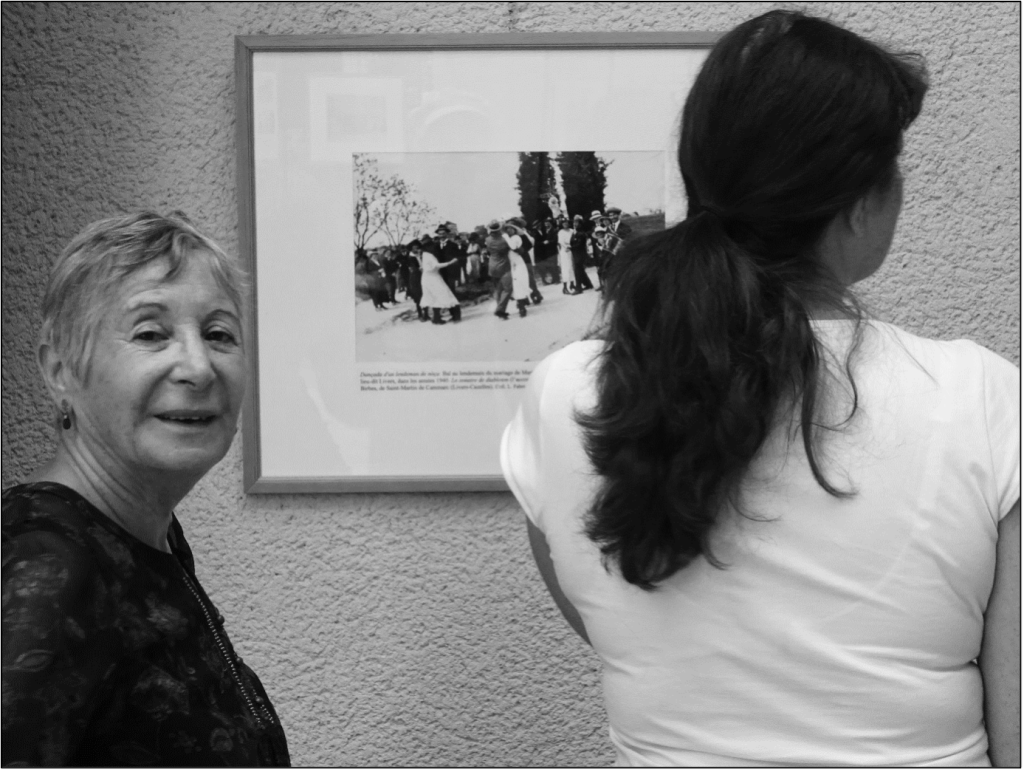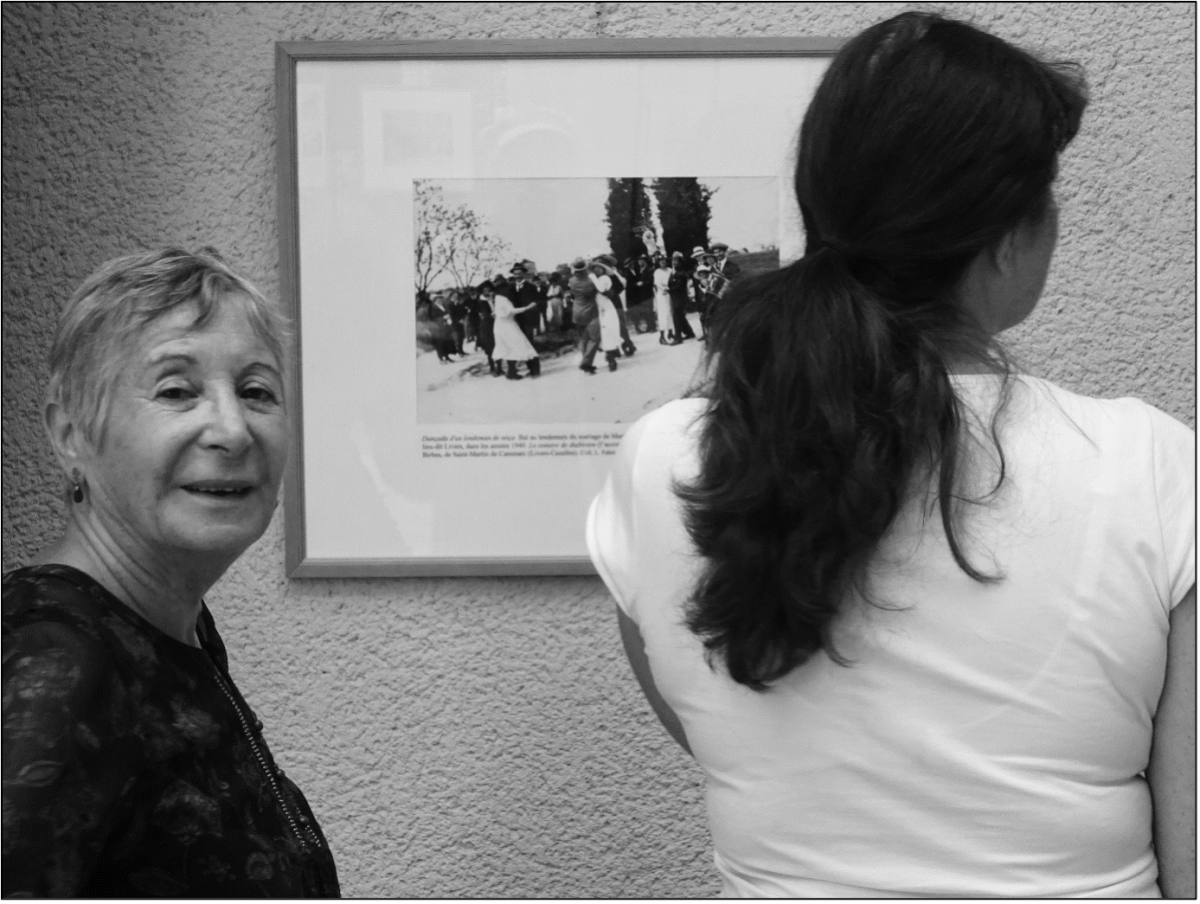by Hazel Anna Rogers for the Carl Kruse Arts Blog

This is a photograph of two women in front of a photograph of couples dancing.
You do not know these women.
What can we deduce from this image? Many a thing. The old woman is looking at the camera. She knows she is being watched. But it seems as though there is a roughness to her shape, potentially indicating that she has recently turned her head and only just observed her onlooker, thus her expression could be one of shock, or surprise. She is smiling – does she know her voyeur? Is she posing for them? Do we see a melancholy in her eye, something tired and weary of life? The woman turned away from us – does she know the old woman? Does she know she has been seen? Is she observing another photograph beside the one before her, or might she be gazing off in a reverie about the dancing people, or, perhaps, has she spotted someone else that she knows? And on the form of the photograph – is this a triptych of sorts, a three-part story in a zigzag pattern from right to left of young (the faceless woman), old (the old woman), and older, but likely passed from this world (the people in the photograph)? Are we being shown the course of life through this photograph? Is this a play on Magritte’s Le Chef-d’Oeuvre ou les Mystères de l’Horizon (1955), where all parties exist within the same frame and yet simultaneously exist within their own realities? Or maybe this is a feminist piece, one centred on revealing the beauty of old age as being in the wizened, knowing eyes and smile-creases on an elderly woman as opposed to the younger woman, whose beauty is in her flesh, her form, and so her face is not shown, as opposed to the women in the photograph whose beauty is used solely for the entertainment of the men they are dancing with?
All of these are tepid assumptions, just like most of those propounded in popular artistic and literary theory. But I’m sure you warmed to one or another, thinking it to bear some truth.
The woman looking to the camera is my mother’s mother, and the other woman is my mother. I took the photograph when we were visiting a gallery on a hot summer’s day in France, where my grandmother lives, and where my mother is from. You see how I was able to use this image to promulgate any theory I wished, any social cause that came to mind, any artistic vision that I could think of off of the top of my head. I could swindle you, tug you in to believe any narrative I wished just through using believable-sounding words.
Peter Brook, in his novel The Empty Space, asks this pertinent question: ‘Is it that we are living in an age of images?’. I think we do. As illustrated by my annoying and somewhat pretentious vernacular about the photograph above, it is clear that meaning can be gleaned without the need for language, for, as John Berger asserts in his text Ways of Seeing; ‘Seeing comes before words’, and further that ‘this seeing which comes before words [] can never quite be covered by them’. We are born with an innate propensity towards the visual, and it is from the visual that we oftentimes learn language.
We have known the significance of images as importers of meaning since the beginning of time; for what is a painting if not a meaning, an explanation of a feeling, a narrative without words? For what is a photograph, if not a condensing of words and emotions within a frame? But, perhaps, words can also exist as images. Perhaps we should not limit the term ‘image’ to denote something purely visual in this instance. Take the Noh play, for instance. Not much ‘happens’ in a Noh play. That is to say there are not many events within traditional Noh plays. A Noh play could be said to be a visualisation of a metaphor, peppered with historically prominent symbols and actions. Because of this, the dialogue in a Noh play tends to be limited, allowing space for meaning to be derived from the specificity of its choreography and instrumental accompaniment. The Noh play creates a series of images, images passed down generation after generation, whose perfect translation is facilitated by the use of masks on its performers. The specificity of the movement, music, and setting of a Noh play is strictly protected by the Nohgaku Performers’ Association (Nōgaku Kyōkai), and so it is indeed possible that a Noh play performed some 200 years ago may be a mirror image to the same play performed today.
What I know of Noh Theatre has mostly come from Toyoitiro and Toyoichirō Nogami’s comprehensive text Japanese Noh Plays: How to See Them (2005), which details the essential structural and artistic components of Noh Theatre. To avoid simply regurgitating the Nogami’s scripture, I shall describe the environment of Noh as best I can in my own words: there is the stage, where the actors perform; the back stage, where the musicians and prompters seat themselves; the veranda to the right, where the chorus performs; and the corridor to the left, where the musicians and actors journey to and from the stage. This corridor is also known as the Bridge. There is a pine tree painted onto the wall at the back of the stage. This tree is ever present in all Noh performances. The set does not change, regardless of which play is performed. It is up to the performers themselves to make something happen.
Why do I bring up Noh in my discussion of images? Consider my comment on assumptions and vernaculars propounded by popular literary and artistic theorists. While I was studying literature in Brighton, I came across many tedious commentaries made about such prolific writers as Shakespeare, Twain, and Hemingway. In the West, we are constantly preoccupied with finding the political issues, the social issues, the identity issues associated with art. We find this in both the literary and plastic arts. An image cannot simply be one, or simply be beheld for its beauty, or its enlightening insights on this fickle, strange thing we call life. In the West, we act as if it is of the utmost importance for us to reduce an image down to the gender, political leanings, and social status of its creator and of the characters they depict. We act as if this will give us a greater knowledge of art, but, in fact, it reduces art by looking behind the canvas, or the page, rather than at it. In the West, we decide that we can no longer look at certain books, certain artworks, certain buildings, because we believe that this act of erasure will make us better people. In the West, we decide to adapt pieces of work to make them more palatable to our audiences. Noh refuses this. Noh remains as Noh has always been; an image solidified through the centuries.
It is true that we are living in an age of image, as Brook believes, but it is also true that these images lack constancy – we are so hungry to find the images that we believe we want that we find ourselves inundated with such a vast amount of them that we no longer know where to look. Instagram, TikTok, adverts, YouTube, immersive gallery showings, memes, GIFs, emojis; these are the facilitators of our hunger for the perfect image, an image that supports our political and social leanings, an image whose creator is unproblematic, an image that satisfies us aesthetically. We are greedy, these days. It seems that we are beginning to lack the humility to acknowledge the potential of l’art pour l’art, or art for art’s sake; that is, that the fundamental value of art is separate from its political, moralistic, or ethically instructive function. Of course, that is not to say that art is meaningless, because it is surely not. Art, as Nietzsche asserts, is ‘the great stimulus of life’ (Twilight of the Idols: or How to Philosophize With a Hammer, 1889), and the meaning we glean from it is so subjective and personally driven that I simply argue that it is an insanity to try and pin down a work with its backstory, and further to reject or embrace it purely as a result of that backstory.
In Noh, we can look onto the stage, and realise that no matter how many images we destroy or create, nothing can change the fundamental things of life that Noh portrays, amongst them being love, death, and the magical mysteries of life itself. Noh unknowingly rejects our penchant towards the politicisation of art by presenting us with an unchangeable form, one which does not cater to our erratic political and didactic whims, and invites us simply to watch and see all the bountiful emotions and experiences that frame the oddity of our human existence.
Perhaps I am wrong. Of course, Noh addresses socio-political issues of its time, and other issues therein, because it is almost impossible to create an art that does not reflect one’s lived experience of the time one is living within. But, as Earle Ernst propounds, Noh is ‘an exquisitely precise theatre based on the artistic principle of reduction to essential forms’ (The Influence of Japanese Theatrical Style on Western Theatre, 1969); it is the form of Noh that is its artistic power, its inimitable fusion of voice, movement, dance, music, acting, poetry, and prose to create enduring images. It is Noh theatre that presents the ultimate challenge to our currents views about art.
===========
The Carl Kruse Arts Blog homepage is at https://carlkruse.net
Contact: carl AT carlkruse DOT com
Other articles by Hazel Anna Rogers include When The Show Is Over, Finding My Clown, Acting and Art, and What Does it Mean to be Wealthy.
Carl Kruse is also on Buzzfeed.
